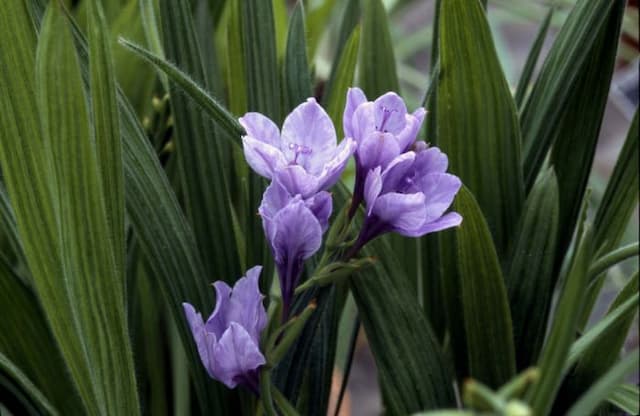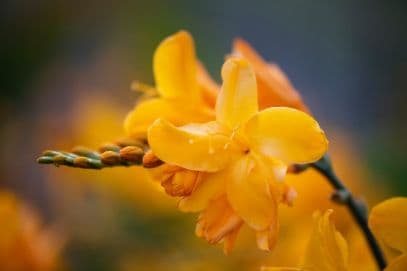Golden Crocus Crocus × luteus 'Golden Yellow'

ABOUT
Crocus 'Golden Yellow' features striking, vibrant golden-yellow flowers that are often one of the first hints of spring. Each bloom is cup-shaped with slightly pointed petals, which open wide on sunny days to create a star-like appearance. The bright yellow is contrasted by a deep orange stigma in the center, adding to its ornamental value. The foliage is thin and grass-like, emerging either alongside or shortly before the flowers. The leaves are deep green, sometimes featuring a silvery stripe down the center. This provides a delicate backdrop that further enhances the visual appeal of the blooms. The flowers are borne on short, slender stems that nestle just above the foliage. The overall effect of Crocus 'Golden Yellow' is that of a sunny, cheerful harbinger of warmer days, making it a popular choice for gardeners looking to add a splash of early spring color.
About this plant
 Names
NamesFamily
Iridaceae.
Synonyms
Dutch Yellow Crocus, Golden Crocus, Spring Crocus, Yellow Crocus.
Common names
Crocus × luteus 'Golden Yellow'.
 Toxicity
ToxicityTo humans
The plant commonly known as Dutch Yellow Crocus generally has a low level of toxicity to humans. However, if ingested in large amounts, parts of this plant might cause gastrointestinal discomfort, including nausea, vomiting, and diarrhea. Eating the corms (the bulb-like structures) could result in more severe symptoms due to their higher concentration of compounds that can be toxic. It is always advisable to keep any plant material out of reach of small children to avoid accidental ingestion.
To pets
The plant known as the Dutch Yellow Crocus is considered to have low toxicity for pets, such as cats and dogs. However, ingestion of the plant parts, especially the corms, can lead to gastrointestinal upset, which may manifest as vomiting or diarrhea. While the symptoms are typically mild, pets that consume large amounts of any part of the plant may experience more severe digestive problems. Pet owners should prevent their pets from ingesting plants, as the specific reaction can vary between individuals.
 Characteristics
CharacteristicsLife cycle
Perennials
Foliage type
Deciduous
Color of leaves
Green
Flower color
Yellow
Height
0.25 feet (7.62 cm)
Spread
0.25 feet (7.62 cm)
Plant type
Bulb
Hardiness zones
3
Native area
Europe
Benefits
 General Benefits
General Benefits- Early Spring Blooms: adds vibrant color to gardens at the end of winter when few other plants are flowering.
- Attracts Pollinators: provides an early food source for bees and other pollinating insects.
- Low Maintenance: requires minimal care once established, making it suitable for novice gardeners.
- Drought Tolerant: once established, it can survive with relatively little water, suited for xeriscaping.
- Naturalizing: can spread and multiply over time, creating larger displays each year without additional planting.
- Versatility: suitable for gardens, pots, rockeries, and as underplanting for deciduous shrubs and trees.
 Medical Properties
Medical PropertiesThis plant is not used for medical purposes.
 Air-purifying Qualities
Air-purifying QualitiesThis plant is not specifically known for air purifying qualities.
 Other Uses
Other Uses```html
- Dye production: The stigmas of the Golden Yellow crocus can be used to produce a natural dye for textiles.
- Artists' pigment: The vibrant yellow hue can be processed into a pigment for use in oil paintings and watercolours.
- Garden design: The Golden Yellow crocus's striking color can be used in garden designs to create a focal point or to brighten up a rock garden.
- Edible decoration: The flowers can be crystallized and used as edible decorations on cakes and desserts.
- Flavoring agent: Crocus petals have been used historically to add flavor and color to gin and other spirits.
- Seasonal crafts: The dried petals can be incorporated into potpourris or used to create natural confetti for festive occasions.
- Culinary symposia: The Golden Yellow crocus can be used as a discussion piece at food events to educate on the historical uses of crocuses in cuisine.
- Fragrance production: While not as common, the petals can sometimes be used to create subtle fragrances for perfumery.
- Photography subject: Its early spring bloom and bright color make the Golden Yellow crocus a popular subject for botanical photography.
- Biodegradable colorant: In eco-friendly manufacturing, crocus petals can be explored as a natural colorant for sustainable fabrics.
Interesting Facts
 Feng Shui
Feng ShuiThe Golden Crocus is not used in Feng Shui practice.
 Zodiac Sign Compitability
Zodiac Sign CompitabilityThe Golden Crocus is not used in astrology practice.
 Plant Symbolism
Plant Symbolism- Youthful Gladness: The crocus often blooms in early spring or late winter, symbolizing the cheerfulness and joy associated with youth.
- Hope: Its arrival is a sign that winter is ending and it brings hope for the coming spring and longer, warmer days.
- New Beginnings: As one of the first flowers to emerge from the cold ground, it represents new life and new ventures.
- Renewal: The blooming of the crocus signifies the cycle of life and the renewal of nature after the winter season.
 Water
WaterThe Golden Crocus requires moderate watering during its growth period. Water deeply when the top inch of soil feels dry, providing approximatively 1 gallon of water per square yard every 7 to 10 days, depending on the weather. Reduce watering after the foliage has died back post-flowering, as the plant enters dormancy. During dry spells in the fall, provide a light watering of about half a gallon per square yard to encourage root development for the next season.
 Light
LightGolden Crocus thrives best in full sun to light shade. Plant them in a spot that receives at least 6 hours of direct sunlight daily to ensure the best flowering performance. Partial shade is acceptable, especially in regions with very intense sunlight, but too much shade can lead to poor flowering.
 Temperature
TemperatureGolden Crocus prefers temperate climates and will flourish in temperatures that range between 35°F and 65°F. It is cold-hardy and can survive winter temperatures down to about 15°F, but extreme heat above 75°F might adversely affect the plant. The ideal conditions for growing Golden Crocus are those of typical spring weather, cool to mild.
 Pruning
PruningPruning is not necessary for Golden Crocus because it will naturally die back after flowering. However, removing spent flowers can tidy up the appearance. Leave the foliage in place until it has died down naturally to allow the bulbs to gather energy for the next season. The best time for any cleanup around the plant is late spring or early summer after the foliage has yellowed and withered.
 Cleaning
CleaningNot needed
 Soil
SoilThe Dutch Yellow Crocus thrives best in moderately fertile, well-drained soil. A mix of equal parts potting soil, sharp sand, and compost or well-rotted manure is ideal. The soil pH should be neutral to slightly alkaline, between 6.0 and 7.5.
 Repotting
RepottingDutch Yellow Crocuses typically don't require frequent repotting and are best when left undisturbed. However, if they become overcrowded after several years, it is best to lift and divide the corms in the late summer after the foliage has died back.
 Humidity & Misting
Humidity & MistingDutch Yellow Crocuses are tolerant of a wide range of humidity levels and do not require a specific humidity level to thrive. They perform well in the average outdoor humidity provided by their natural seasonal cycle.
 Suitable locations
Suitable locationsIndoor
Place Dutch Yellow Crocus in bright, indirect light and cool temps.
Outdoor
Plant in well-draining soil with full sun to light shade.
Hardiness zone
3-8 USDA
 Life cycle
Life cycleCrocus × luteus 'Golden Yellow', commonly known as Golden Crocus, begins its life as a corm, which is a bulb-like storage organ that lies dormant underground during the plant's off-season. In autumn, roots develop from the base of the corm, and leaves begin to emerge, followed by the bright yellow, goblet-shaped flowers that appear in late winter to early spring. After blooming, the foliage continues to grow and photosynthesize, allowing the plant to store energy back into the corm for the next season. Once the leaves yellow and die back in late spring or early summer, the plant enters dormancy, surviving dry or cold periods as a corm. During dormancy, the corm can also produce new cormlets, which will grow into new plants. The cycle repeats yearly with the plant resuming growth from the corm as temperatures and soil conditions become favorable again in autumn.
 Propogation
PropogationPropogation time
Early Fall
Crocus × luteus 'Golden Yellow', commonly known as 'Golden Yellow' crocus, is most commonly propagated by dividing its corms. The best time for this method is in late summer to early fall, after the foliage has died back and the corms have had a chance to store energy for the next growing season. To propagate, you carefully dig up the corms and gently separate the offsets, which are smaller corms that have developed at the base of the parent corm. These offsets can be replanted immediately, placing them about 3 to 4 inches apart and at a depth of 3 to 4 inches (7.6 to 10.2 centimeters). It’s important to ensure that the new planting site is well-drained to avoid rot and has good sunlight exposure to encourage strong growth in the following season.









